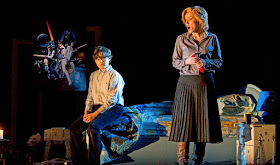New York City Opera presents The Turn of the Screw.
by Paul J. Pelkonen
For the uninitiated, there are differences between Myfanwy Piper's libretto and James' original novella. The novella leaves open the question of ghosts, focusing on the Governess' own descent into madness and telling the story entirely from her own perspective. Britten's opera makes Peter Quint and Miss Jessel terrifying and real, incorporeal, predatory beings whose object is bloody revenge for their deaths. The composer artfully ratchets the tension upwards in 16 scenes, each opening with a variation on the 12-note "screw" theme that permeates the opera. Jayce Ogren led the orchestra, maintaining tension and a creepy atmosphere through the varied palette of the score.
The Governess remains the central character of the opera. Here, she was played by Sara Jakubiak in a riveting performance that forced the singer to push the upper limits of her acting ability and vocal register. The Governess is a difficult role that starts in the lower register and ramps gradually higher and higher as the terrifying forces of Quint and Jessel began to close in. In Ms. Jakubiak's capable hands, this would-be domestic was a picture of ignorance, indecision, and finally disastrous action. Every choice this character makes is the wrong one. Luckily, every musical decision made was correct.
Her young charge Miles played by Benjamin P. Wenzelberg, a 13-year-old conservatory student and gifted boy treble. (He is already experienced in the role of Miles, having played the possessed little boy in a production by Opera Moderne.) Mr. Wenzelberg is at his most terrifying in the opera's later act, when the ghost of Peter Quint has assumed control over his actions. As his sister Flora, Lauren Worsham does not have as much music to sing, but the singer also conveyed eerie innocence corrupted.
As Quint, Dominic Armstrong displayed a potent character tenor with a touch of strain in the most emotional passages. His blood-spattered presence was genuinely scary, helped by clever blocking and lighting design that hid him within the minimal sets. Miss Jessel (portrayed here as having drowned while pregnant, possibly with Quint's own child) was played with intensity and focus by Jennifer Goode Cooper. The oblivious housekeeper Mrs. Grose was given a fine comic performance by contralto Sharmay Mussachio.
Award-winning theater director Sam Buntrock has created a show that makes maximum use of BAM's Howard Gilman Opera House, incorporating lighting tricks, trap-doors and to bring the haunted world of this opera to vivid life. Clever use of found objects (props included a vintage Millennium Falcon Star Wars™ toy) and ordinary-looking household light bulbs lent an eerie domesticity to this story of innocence corrupted and childhood destroyed. In other words, it's exactly the sort of show City Opera did well before leaving Lincoln Center.
by Paul J. Pelkonen
For the uninitiated, there are differences between Myfanwy Piper's libretto and James' original novella. The novella leaves open the question of ghosts, focusing on the Governess' own descent into madness and telling the story entirely from her own perspective. Britten's opera makes Peter Quint and Miss Jessel terrifying and real, incorporeal, predatory beings whose object is bloody revenge for their deaths. The composer artfully ratchets the tension upwards in 16 scenes, each opening with a variation on the 12-note "screw" theme that permeates the opera. Jayce Ogren led the orchestra, maintaining tension and a creepy atmosphere through the varied palette of the score.
The Governess remains the central character of the opera. Here, she was played by Sara Jakubiak in a riveting performance that forced the singer to push the upper limits of her acting ability and vocal register. The Governess is a difficult role that starts in the lower register and ramps gradually higher and higher as the terrifying forces of Quint and Jessel began to close in. In Ms. Jakubiak's capable hands, this would-be domestic was a picture of ignorance, indecision, and finally disastrous action. Every choice this character makes is the wrong one. Luckily, every musical decision made was correct.
Her young charge Miles played by Benjamin P. Wenzelberg, a 13-year-old conservatory student and gifted boy treble. (He is already experienced in the role of Miles, having played the possessed little boy in a production by Opera Moderne.) Mr. Wenzelberg is at his most terrifying in the opera's later act, when the ghost of Peter Quint has assumed control over his actions. As his sister Flora, Lauren Worsham does not have as much music to sing, but the singer also conveyed eerie innocence corrupted.
As Quint, Dominic Armstrong displayed a potent character tenor with a touch of strain in the most emotional passages. His blood-spattered presence was genuinely scary, helped by clever blocking and lighting design that hid him within the minimal sets. Miss Jessel (portrayed here as having drowned while pregnant, possibly with Quint's own child) was played with intensity and focus by Jennifer Goode Cooper. The oblivious housekeeper Mrs. Grose was given a fine comic performance by contralto Sharmay Mussachio.
Award-winning theater director Sam Buntrock has created a show that makes maximum use of BAM's Howard Gilman Opera House, incorporating lighting tricks, trap-doors and to bring the haunted world of this opera to vivid life. Clever use of found objects (props included a vintage Millennium Falcon Star Wars™ toy) and ordinary-looking household light bulbs lent an eerie domesticity to this story of innocence corrupted and childhood destroyed. In other words, it's exactly the sort of show City Opera did well before leaving Lincoln Center.

